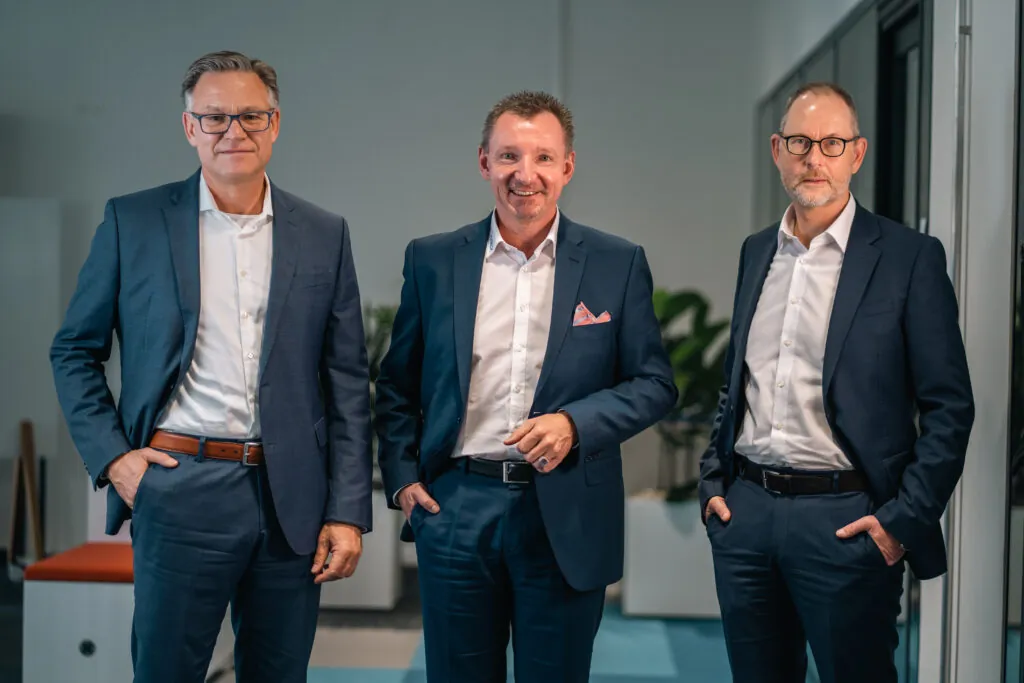
IT Organisation 2025

On course for transformation: “You need the North Star and lighthouses”
Agile processes speed up the development of digital services. In an interview with Thomas Heinevetter, Managing Director of kobaltblau Management Consultants GmbH, Daniel Thomas, Board Member for Business Organization, Digital Services and IT at HUK- COBURG, explains how cooperation between a specialized unit and traditional IT works and what it can achieve.
What does the future cooperation between IT and business look like?
Thomas Heinevetter: What does the future cooperation between IT and business at HUK- COBURG look like? There are four scenarios to choose from: 1. business and IT merge completely. 2. the IT is split into two parts; the business-related area merges with the business as in scenario 1, the infrastructure area is organized as platform or foundational IT. 3. the focus is on product IT and is similar to the second, but instead of dedicated teams, virtual teams from business and IT work together end-to-end. 4. the scenario is close to today’s structure: there are mixed virtual teams, but also classic plan-build-run teams in IT. Where is IT heading at HUK COBURG?
Daniel Thomas: HUK-COBURG’s IT will move towards scenario three in five years’ time.
Heinevetter: What are the areas that are leading the way in new collaboration models?
Thomas: You have to look very carefully at where which model is advantageous. Areas that are subject to trends and major uncertainties are predestined for end-to-end product responsibility. Here, teams – whether virtual or permanently assigned – must work as autonomously, independently and quickly as possible.
Heinevetter: Even as a citizen developer and on the basis of no-code or Low-code platforms?
Thomas: That depends on which problem is being addressed. If valuable IT resources are to be relieved or conserved, this can be a solution. However, an inventory management system cannot be implemented in this way. The question of no-code or low-code does not arise even if the specialist side is not yet aware of the solution to a problem.
Heinevetter: What are the factors that make product orientation and product-oriented teams successful?
Thomas: It’s all in the mix. It is important to bring together the right skills with the right expertise in an interdisciplinary team – whether virtually or physically in one unit or in several units.
Heinevetter: What is special about your ‘Digital Services’ department?
Thomas: We have learned from our project activities in previous years when designing the customer interface. The rather loose project organization had to be structurally underpinned. The reason: due to the sometimes difficult and lengthy coordination with the numerous stakeholders, the desired speed was lacking. The Digital Services department provides the framework and certain skills. Your task: Developing digital services for end customers together with the business managers. These include websites and apps, such as the telematics services. The special feature: This department has no business responsibility. It provides the skills and processes. The Product Owner sits on the business side, contributing the specialist skills. Product Owner and Digital Service Owner form a tandem.
Heinevetter: Does this follow the Spotify model, in which competence-related teams are bundled and then made available virtually and dynamically according to requirements or projects?
Thomas: That was the goal. In the DS department, for example, the number of digital service teams can vary. The teams are dynamic and organized according to skills. They remain constant over a certain period of time so that the members get to know each other, and the processes settle in. We are currently managing to implement the numerous planning requirements and projects accordingly.
Heinevetter: How does the collaboration with traditional IT work?
Thomas: Traditional IT still exists. Digital Services as a department is embedded in an IT department that is otherwise organized according to the classic plan-build-run approach. There are of course interfaces, for example with application development and the business organization, which includes the Business Intelligence Center, which takes care of data management, data warehouse and data lake issues. And it bases its development and production environments on infrastructure services provided by the IT Operations department. This will be accompanied by internal automation. The ideal scenario: For developers in the DS department, it no longer makes any difference whether they are putting together a development environment from the Amazon Cloud or from the internal cloud. If possible, this should be self-service and automated.
Heinevetter: Could the Digital Services division be a blueprint for other divisions?
Thomas: We are already borrowing from it today. This makes sense because, for example. components such as the HUK service platform, which was built explicitly for this purpose. This direction will be pursued further.

Heinevetter: How will the role of demand management develop?
Thomas: In some cases, the Product Owner will take on the role of Demand Manager – for us, this means the Business Lead on the specialist side. It should bundle the requirements that come from the various departments, prioritize them and determine what needs to be done in the next sprint. However, the lion’s share – across the entire Group – is still accounted for by traditional requirements management, which tends to follow the waterfall model.
Heinevetter: Do you believe that more agility will be introduced here too?
Thomas: The proportion of agilely managed and planned projects will increase because the reaction time to market conditions will shorten. To achieve this, both systems must be optimally coordinated.
Heinevetter: Different processes – yet a common portfolio. What are the challenges?
Thomas: A new car insurance rate, for example, requires more than a new digital service in the front end of a rate calculator. The technological basis of the stationary sales units is, for example must be considered separately and advisory systems must be updated. These dependencies need to be taken into account, which in part slow down agility and flexibility. One of the challenges is to reduce dependencies in order to give the agile units – whether in the Digital Services department or in other departments of the IT division – room to maneuver. This also applies to the back-end units, where there are many dependencies from the past. The top priority in the past was to conserve resources because IT resources were expensive. These purely efficiency-oriented times are over.
Heinevetter: Is there a target scenario for the frequency of updates?
Thomas: In a scenario in which waterfall topics intersect with ‘agile’, a great deal of coordination is required, which has an impact on the planning process. The general aim is to react much faster to market conditions. And we are picking up speed with the agile approach.
Heinevetter: Speed requires resources. What does ideal resource or skill management look like that guarantees speed?
Thomas: I’m a fan of professional skill management. It has the advantage that the resources that are available are actually backed up by valid skills. This means that skills can also be assigned at short notice or even automatically. ‘Automated’ does not mean that assignments are made over the heads of employees. Skill management is only successful if skill requirements match the qualifications of the employees, ideally motivating them intrinsically.
Heinevetter: Modern, agile skills management goes hand in hand with a change in roles and the expectations placed on them. How is the role of a manager changing, for example in terms of people lead or product lead?
Thomas: In the Digital Service department, for example, the disciplinary manager is responsible for skills development (= people lead). However, she still has a lead function for the segment for which she is responsible, for example UX. In contrast, the Digital Service Owner manages the development of digital services together with the Business Lead (=Product Lead).
Heinevetter: On the subject of data organization or data-driven companies. Will HUK Coburg eventually have a separate organization for Data LifeCycle Management with the role of a CDO?
Thomas: The insurance industry’s business model has always been based on working with data and extracting information from data in order to calculate premiums or risks. However, the requirements of customers are changing and today they often draw comparisons with Amazon or Google. In order to keep pace and increase convenience for customers, it makes sense to use data from many data pools. The task now is to build an organization that can achieve this. A central unit that is responsible for everything that happens with the data is rather unsuitable for this. However, it should at least create the basic framework conditions. This includes, for example, the design of data analytics governance.
Heinevetter: What can data scientists do?
Thomas: This topic is complex. It is an illusion that a data analyst or scientist can create a model that solves all problems. This will neither win customers nor increase customer satisfaction. Rather, the result of this model must lead to new services, processes and the optimization of core processes. That is data excellence. The basic prerequisite: data must not be isolated by today’s data owners, but must be made accessible to the company in principle.
Heinevetter: What does the solution look like for you?
Thomas: A good and suitable model for HUK-COBURG is probably a hub-and-spokes model: a central unit – the hub – with a clear Group-wide mission and with a bracketing function for the spokes, i.e. the decentralized data analytics units.
Heinevetter: What would be the topics for the central unit?
Thomas: The central unit could be set up by the management, for example. receive the main assignment: Maximize the value from our data for our company and concerted implementation by the decentralized data analytics units. Similar to project planning, it provides for exampleB. put together a data analytics portfolio.
Heinevetter: What are the most important success factors in shaping such transformations?
Thomas: If you don’t know what the North Star looks like, you won’t find it in the sky. A company must know, set and maintain its course. If the course of the individual management boards is only a few degrees apart, then there will ultimately be deviations that make the goal seem a long way off. There will certainly always be readjustments, but we should keep a close eye on the North Star. And it needs beacons and simple strategic indicators that motivate, such as an increase in customer numbers.
Heinevetter: What are your top 3 areas for action?
Thomas: One of HUK-COBURG’s top areas of activity continues to be digital services. The Group must become significantly more digital in its service offering. First and foremost, digitalization also means reducing complexity, simplifying processes and then thinking about how the results can be integrated into a digital service portfolio.
The second point is the topic of data excellence. It takes time for an organization to internalize the topic and establish the processes that will then have an impact.
And the third major field is skill management. What should this look like in the future? How do we recruit the right skills and how do we enable our own employees to take on the roles required in the future? These are all questions that we need answers to today.

Daniel Thomas
Daniel Thomas – born in 1976 – studied industrial engineering at the University of Karlsruhe. He began his professional career at HUK-COBURG in 2002. In 2011, he became Head of the Motor Vehicle Operations department, in 2014 General Representative of HUK-COBURG and at the same time Deputy General Representative of HUK-COBURG. Member of the Management Board of HUK24. Daniel Thomas has been a member of the Board of Management of the HUK-COBURG Insurance Group since January 2016 and is responsible for the areas of business organization, IT application development and operations as well as digital services.




